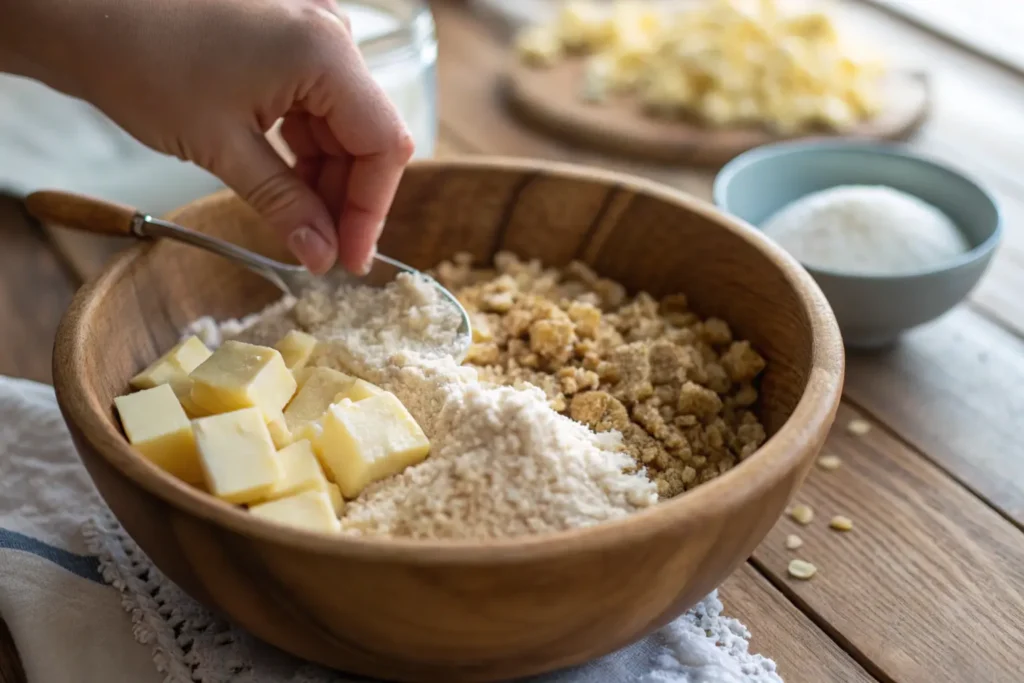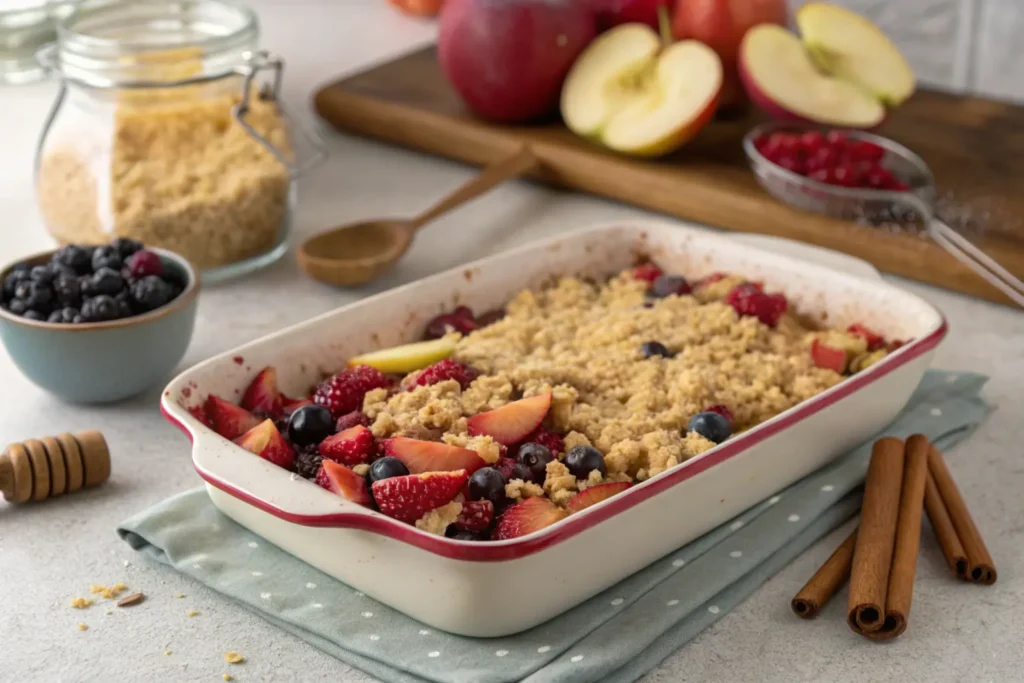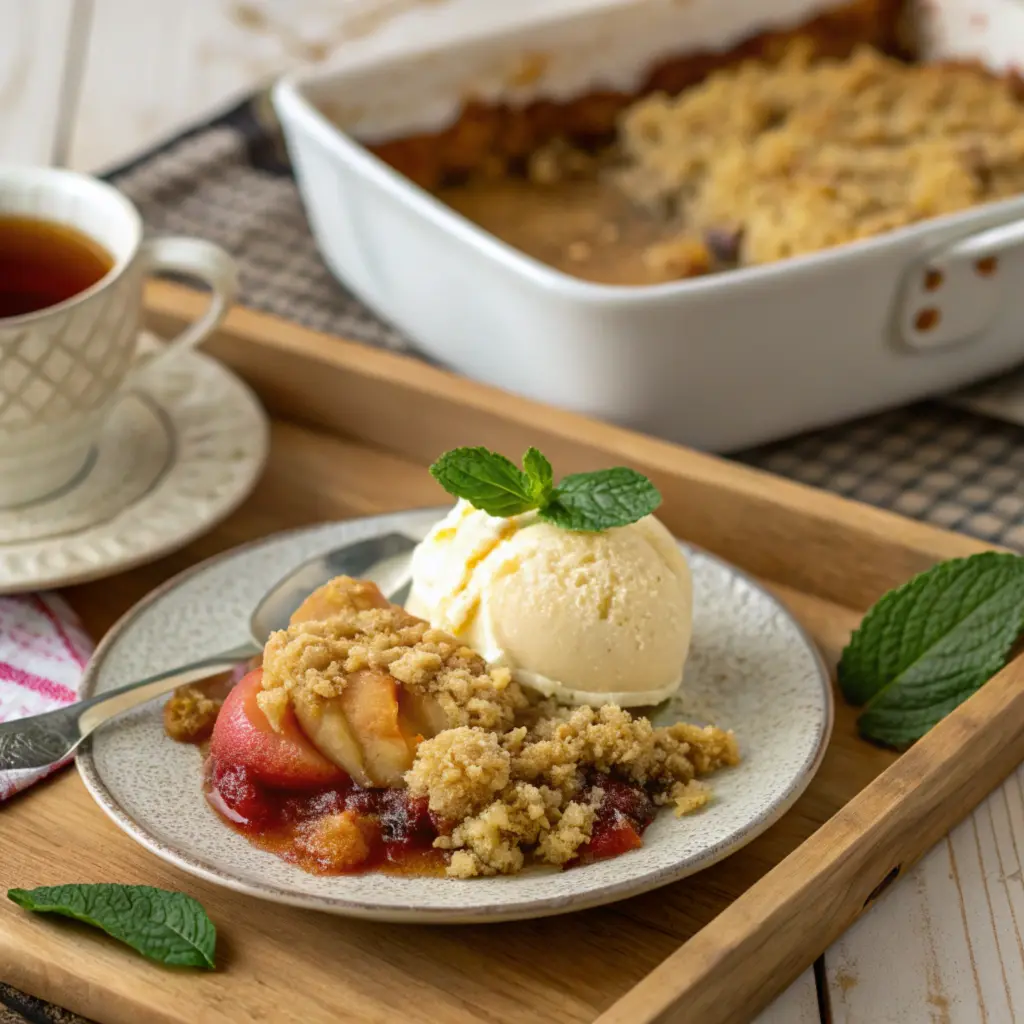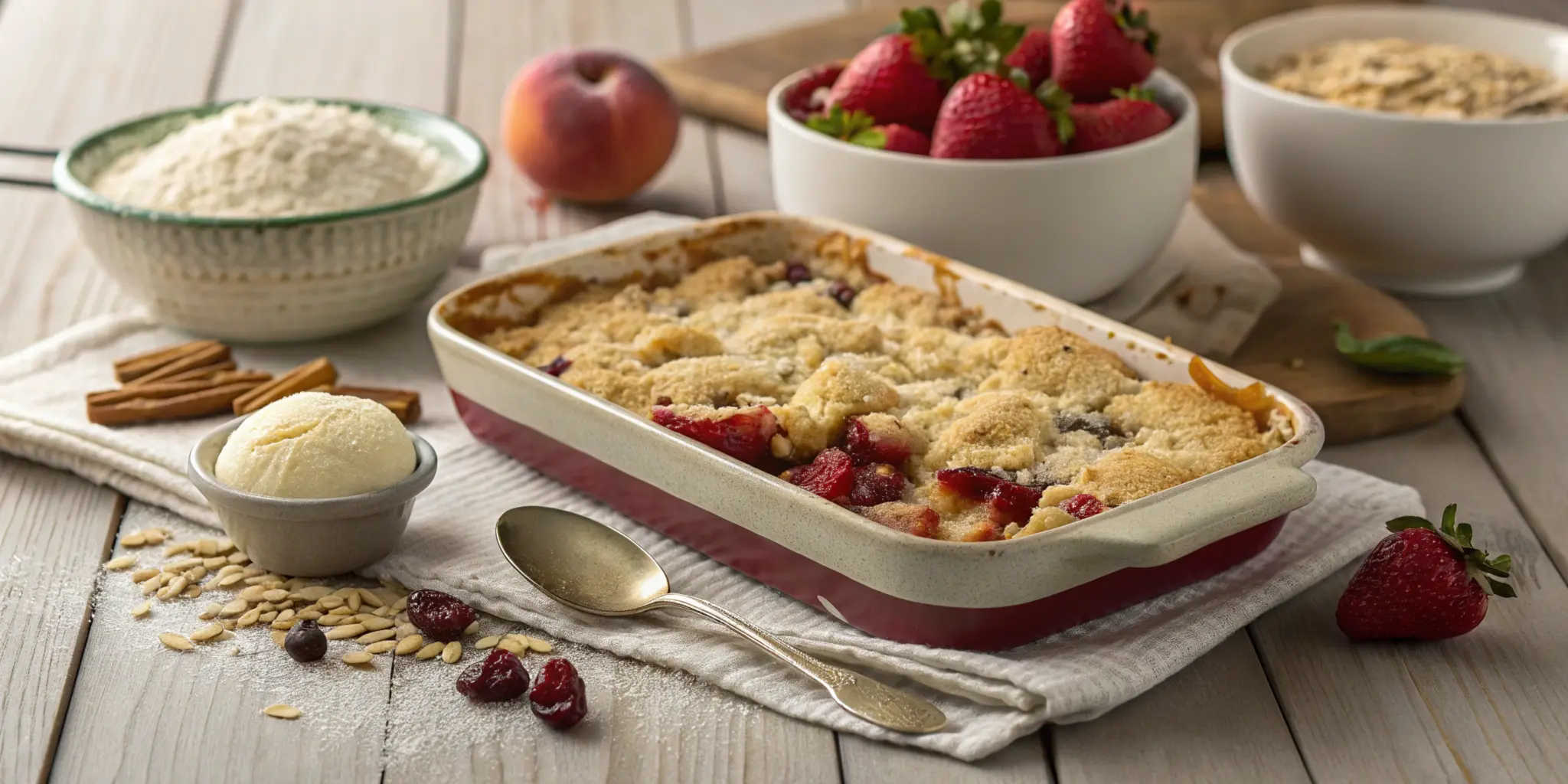When it comes to desserts, few things bring comfort like a warm, homemade crumble. But, have you ever wondered what is the secret to good crumble? It’s not just about tossing some fruit and topping into a dish—it’s a delicate balance of texture, flavor, and baking technique. From selecting the perfect fruits to crafting a golden, crunchy topping, every step counts. This article takes you through all the essential elements to create a crumble that’s as delightful to eat as it is to make.
What is a Crumble?
A crumble is a classic dessert that combines a sweet fruit filling with a buttery, crumbly topping. Unlike pies or cobblers, the topping doesn’t include a bottom crust. Instead, it’s a delightful mix of flour, sugar, and fat, often with oats or nuts for added crunch. This simplicity is part of its charm, but achieving the right balance is key.
The Origin of Crumbles
Crumbles trace their roots back to Britain, where they became popular during World War II due to rationing. Lacking ingredients for elaborate pastries, home cooks created this simpler alternative, which has since evolved into a beloved treat worldwide.
Variations Across the Globe
While traditional crumbles often use apples or berries, cultures have adapted the recipe to suit local fruits and flavors. In the United States, you’ll find peach or cherry variations, while in tropical regions, mango and pineapple crumbles are popular. Despite the differences, the core idea remains the same: a perfect harmony of fruit and topping.
Seasonal Fruit Selection
Choosing the right fruits for your crumble isn’t just about taste; it’s also about seasonality. Fresh, in-season fruits provide better flavor, texture, and even nutritional value. During autumn, apples and pears are popular choices. In summer, berries like strawberries, blueberries, and raspberries take the spotlight. Using seasonal fruits ensures your crumble is both flavorful and cost-effective.
For those who love experimenting, mixing fruits can bring exciting results. For instance, a combination of tart rhubarb and sweet strawberries in the spring creates a balance that’s hard to beat. And don’t forget, frozen fruits can be a lifesaver when fresh options are limited—they work just as well with minimal preparation.
Balancing Sweet and Tart Flavors
The key to a memorable crumble lies in the balance between sweet and tart flavors. Too much sweetness can make it cloying, while excessive tartness can overpower the topping. Fruits like apples, peaches, and mangoes lean sweet, while rhubarb, cranberries, and some berries add a sharp contrast.
Blending sweet and tart fruits together works wonders. Imagine combining sweet peaches with tart blackberries or mellow apples with sharp cranberries—it’s a flavor profile that keeps every bite exciting. When in doubt, add a splash of citrus juice like lemon or orange to elevate the natural flavors of the fruit filling.
For an easy-to-follow, delicious recipe, check out The Ultimate Peach Crumble Recipe: A Delicious, Easy-to-Make Dessert for step-by-step instructions.
Preparing the Fruit Filling
Peeling, Coring, and Slicing Techniques
Fruit preparation is a crucial step that can influence both the appearance and texture of your crumble. Apples, for example, should be peeled and cored before slicing into uniform pieces. This ensures even cooking and prevents tough, chewy skins from ruining the filling. Soft fruits like berries or plums usually don’t need peeling, which makes them perfect for quick crumbles.
Sharp knives and peelers can make this task a breeze, but there’s no harm in using kitchen gadgets like an apple corer or mandoline slicer to speed things up. Consistency in size matters; large chunks might undercook while smaller ones turn mushy.
Enhancing Flavor with Spices and Sweeteners
To take your fruit filling to the next level, consider adding spices and sweeteners. Classics like cinnamon, nutmeg, and cloves complement apples and pears beautifully, while vanilla extract pairs wonderfully with berries. Don’t shy away from ginger for tropical fruits like pineapple or mango—it adds a zing that makes the dish unforgettable.
For sweeteners, granulated sugar is a staple, but alternatives like brown sugar, honey, or even maple syrup can add depth. Adjust the amount based on the natural sweetness of your fruits. A small pinch of salt might seem unusual, but it helps balance and highlight the sweetness, ensuring your crumble isn’t one-note.
Essential Ingredients for the Topping: What is the Secret to Good Crumble?
The Role of Flour and Oats in a Perfect Crumble Topping
When uncovering what is the secret to good crumble, the topping’s ingredients play a pivotal role. Flour acts as the backbone, binding the other components and offering a neutral base that allows the butter and sugar to shine. All-purpose flour is a go-to choice, but for added flavor and texture, you might try almond flour or whole wheat flour.
Oats bring an extra layer of chewiness and rustic charm to the topping. Rolled oats are superior to instant oats, as they retain their shape better during baking. Combining flour and oats results in a topping that strikes the perfect balance between crispiness and softness, elevating the overall crumble experience.
For more tips on choosing high-quality ingredients like oats and flour, visit Farm Flavor for guidance on using farm-fresh products in your kitchen.

Why Cold Butter is Key to the Best Crumble Topping
Cold butter is essential for achieving the crumbly, flaky texture that defines a great crumble topping. When cold butter is incorporated into the dry ingredients, it creates tiny pockets of fat that melt during baking, leaving behind a tender crunch.
Using butter that’s warm or melted can lead to a dense, greasy topping—definitely not what you want when aiming for perfection. Dice the butter into small cubes and chill it before mixing. For an even distribution, some bakers freeze the butter and grate it directly into the dry mixture.
No matter the method, the secret to success is ensuring the butter stays cold throughout the preparation process. This step ensures your crumble topping turns out golden, crispy, and utterly delicious every time.
Mastering these essential ingredients and techniques ensures you’re one step closer to answering what is the secret to good crumble. Each choice, from the type of flour to the temperature of the butter, contributes to creating the perfect topping!
Mixing Techniques for Optimal Texture in a Crumble
Hand Mixing vs. Food Processor: Which is Better for a Perfect Crumble Topping?
When discovering what is the secret to good crumble, mixing techniques play a pivotal role in achieving the ideal texture. Hand mixing and food processors are two popular methods, each with unique advantages.
Hand mixing gives you full control over the size of the crumbs. By rubbing cold butter into the dry ingredients using your fingertips, you can create a mixture that resembles breadcrumbs. The tactile process is satisfying and allows you to feel when the topping reaches the right texture. However, it can be time-consuming and requires a bit of patience.
Using a food processor, on the other hand, offers speed and consistency. With just a few quick pulses, you can break down the butter and combine it evenly with the flour and sugar. But caution is crucial here—overmixing can turn the mixture into a paste, which will compromise the desired crumble texture. Always use short bursts to keep the butter in small, solid pieces.
Achieving the Right Consistency for Crumble Topping
Whether you’re mixing by hand or with a food processor, consistency is the cornerstone of a great crumble topping. The mixture should resemble coarse breadcrumbs, with a combination of smaller and larger crumbs. This variation contributes to the distinct texture that’s both crispy and tender.
The key to maintaining this texture is avoiding overworking the mixture. Once the butter is evenly incorporated and the crumbs hold together when pinched, it’s time to stop mixing. Overmixed crumble can become heavy and dense, losing the light, crumbly quality that makes this dessert so appealing.
Remember, what is the secret to good crumble isn’t just about the ingredients; it’s about how they’re combined. These techniques ensure your topping turns out just right every time!
Assembling the Crumble: Tips for Perfect Layering
Layering Fruit and Topping for the Perfect Crumble
When learning what is the secret to good crumble, proper assembly is key. Start by spreading your prepared fruit filling evenly across the bottom of a baking dish. The fruit layer should be thick enough to create a juicy base while remaining shallow enough to avoid becoming overly soggy during baking.
Once the fruit is evenly distributed, sprinkle the crumble topping generously over the filling. An even layer ensures every bite delivers the perfect balance of crispy topping and tender fruit. Don’t worry if some crumbs are larger—they add a delightful texture and enhance the visual appeal of your dessert. However, avoid pressing the topping down too firmly; it’s meant to stay light and airy, not compacted and dense.

Choosing the Right Baking Dish for a Good Crumble
Your choice of baking dish can influence how well your crumble bakes and looks. For a beautifully crisp topping, a shallow, wide dish is ideal. This shape provides excellent topping-to-fruit ratios and ensures even cooking.
Glass or ceramic baking dishes are excellent options as they distribute heat evenly and allow you to see the bubbling fruit through the sides—a sign that your crumble is cooking properly.
If you’re serving guests, ramekins or individual oven-safe bowls are a fantastic choice. They’re charming, customizable, and prevent guests from fighting over the best portion. No matter what dish you choose, make sure it’s deep enough to hold the fruit and topping without risking spills as the juices bubble up during baking.
Mastering the assembly process is just another piece of the puzzle in answering what is the secret to good crumble. Every layer, from the fruit to the topping, contributes to the delicious final result!
Baking Guidelines
Optimal Temperature and Timing
Baking a crumble at the right temperature ensures a crisp topping and tender fruit. Typically, 350°F (175°C) is a sweet spot for most recipes. Preheating the oven is essential to cook the crumble evenly from the start.
The baking time usually ranges from 30 to 45 minutes, depending on the size of the dish and the type of fruit used. Fruits with high water content, like berries, might require a shorter bake time, while firmer fruits, like apples, need longer to soften.
Indicators of Doneness
How can you tell when your crumble is ready? Look for a topping that’s golden brown and a fruit layer that’s bubbling around the edges. These visual cues are reliable signs that everything is cooked to perfection.
Another trick is to insert a fork into the fruit layer to check its softness. If the fruit offers no resistance, it’s fully cooked. For the topping, lightly tap with a spoon—if it’s crisp and crumbly, your dessert is ready to come out of the oven.
Serving Suggestions: Enhancing Your Crumble Experience
Pairing Crumble with Ice Cream or Custard for the Ultimate Dessert
Wondering what is the secret to good crumble when it comes to serving? Pairing it with a creamy addition can elevate your dessert to the next level. A warm crumble topped with a scoop of vanilla ice cream creates a delightful contrast of hot and cold, crunchy and creamy—an irresistible combination that enhances every bite.
Custard is another superb choice, offering a velvety texture that perfectly complements the crumble’s crisp topping and tender fruit filling. Whether served warm or chilled, it pairs harmoniously with both traditional and exotic crumble flavors. And for those who enjoy a lighter touch, whipped cream provides a fluffy, indulgent alternative.

Garnishing Ideas for the Perfect Crumble Presentation
If you’re searching for what is the secret to good crumble when it comes to presentation, garnishing is the answer. A simple dusting of powdered sugar can transform a plain crumble into a visually stunning dessert.
For an aromatic boost, consider adding a sprinkle of cinnamon or nutmeg. These spices not only look appealing but also enhance the flavor profile. Fresh herbs like mint leaves or basil can add a pop of color and a hint of freshness, while a drizzle of caramel sauce introduces a sweet, buttery note.
If your crumble features tropical fruits, toasted coconut flakes make an excellent garnish, adding both flavor and texture. The possibilities are endless—get creative and let your garnish reflect the flavors of your crumble for a polished, delicious finish.
Mastering these serving suggestions ensures you’re not just learning what is the secret to good crumble but also how to serve it in the most delightful way possible!
Overcoming Common Pitfalls When Making the Best Crumble
Preventing Soggy Toppings in Your Crumble
One of the most disappointing outcomes when discovering what is the secret to good crumble is a topping that turns out soggy instead of crisp. This often happens when the topping absorbs too much liquid from the fruit filling, leaving you with an underwhelming texture.
To sidestep this issue, ensure the fruit filling isn’t overly juicy before adding the topping. If you’re working with fruits that release a lot of liquid, like berries or peaches, toss them with a small amount of flour or cornstarch to help thicken their juices during baking. Another trick is to let the fruit sit for a few minutes after mixing with sugar, then drain any excess liquid before layering it in the baking dish.
And here’s a golden rule: never skip preheating your oven! A hot oven ensures the crumble topping bakes quickly, forming a barrier that prevents it from soaking up the fruit’s moisture. This step is crucial in maintaining a crispy, golden topping.
Avoiding Overly Sweet Fillings for a Balanced Crumble
While a crumble is meant to satisfy your sweet tooth, too much sugar in the filling can mask the natural flavors of the fruit, making it overly sweet and unbalanced. The real answer to what is the secret to good crumble lies in letting the fruit’s natural sweetness shine through.
Start by tasting your fruit before adding any sweeteners. If it’s already naturally sweet, reduce the sugar or consider a more nuanced sweetener like brown sugar or honey. For tart fruits, such as rhubarb or cranberries, a little sugar goes a long way in complementing their sharpness.
Finally, don’t forget that the topping itself contributes sweetness to the overall dessert. Over-sweetening the filling can result in a dish that feels one-note. For a subtle depth of flavor, add a small pinch of salt to the filling—it helps balance sweetness and highlights the natural taste of the fruit.
Frequently Asked Questions
How to make peach crumble?
Making peach crumble is straightforward and rewarding. Begin by selecting ripe peaches, peeling and slicing them into even pieces. Toss the slices with a bit of sugar, a dash of cinnamon, and some cornstarch to thicken the juices. Spread the fruit evenly in a baking dish.
For the topping, combine flour, sugar, oats, and cold butter, mixing until the texture resembles coarse crumbs. Sprinkle this mixture over the peaches, ensuring an even layer. Bake in a preheated oven at 350°F (175°C) for about 30–40 minutes, or until the topping is golden and the fruit is bubbling. Serve warm for the best experience!
If you’re looking for a detailed guide on how to prepare peach crumble step by step, check out How to Make Peach Crumble: A Step-by-Step Guide to Perfect Dessert for more tips and tricks.
Does peach crumble need to be refrigerated?
Yes, peach crumble should be refrigerated if you’re not eating it immediately. Once it cools to room temperature, cover it with plastic wrap or transfer it to an airtight container. It can be stored in the refrigerator for up to 3–4 days.
Reheating is easy—pop it in the oven at 350°F (175°C) for 10–15 minutes, or until warm. Refrigeration helps maintain the freshness of the fruit and prevents spoilage.
How to make a crumble topping for peach cobbler?
The crumble topping for peach cobbler is similar to that for a traditional crumble. Combine flour, oats, brown sugar, and a pinch of salt in a bowl. Add cold, diced butter and use your fingertips or a pastry cutter to rub it into the dry ingredients until it resembles coarse crumbs.
For an added twist, you can mix in some chopped nuts or shredded coconut. Sprinkle the topping over the prepared peach filling and bake as directed. The result is a topping that’s crispy on the outside and tender inside, perfect for cobbler.
For a detailed, step-by-step guide on creating the perfect crumble topping for peach cobbler, visit How to Make a Crumble Topping for Peach Cobbler: Step-by-Step Guide.
How to make peach crumble pie?
Peach crumble pie is a delightful variation of the classic crumble. Start with a pre-baked pie crust as the base. Prepare a peach filling similar to a regular crumble by tossing sliced peaches with sugar, spices, and cornstarch.
Pour the filling into the pie crust and top it with a crumble mixture of flour, sugar, oats, and butter. Bake at 375°F (190°C) for 40–50 minutes, or until the topping is golden and the filling is bubbling. The crust adds an extra layer of texture, making this dessert a real showstopper.
What is the difference between a peach crumble and a peach crisp?
The main difference lies in the topping. A peach crumble typically includes a mixture of flour, sugar, and butter, sometimes with oats for added texture. It has a soft, crumbly finish.
A peach crisp, on the other hand, always includes oats in the topping, giving it a distinctively crunchy texture. Nuts may also be added to crisps for an extra layer of crunch. Both are delicious, but the choice depends on whether you prefer a tender crumble or a crispy topping.
For a thorough breakdown of the differences between peach crumble and peach crisp, visit Peach Crumble vs. Peach Crisp: Key Differences Explained.
Conclusion: What is the Secret to Good Crumble?
Crafting the perfect crumble is both an art and a satisfying endeavor. To truly uncover what is the secret to good crumble, it’s essential to focus on every detail—from selecting the freshest fruits and balancing flavors to mastering the crumble topping’s texture. These elements come together to create a dessert that’s as comforting as it is delicious.
Whether you’re preparing a classic peach crumble, exploring seasonal fruit combinations, or trying variations like a crumble pie, the journey is part of the joy. Each step, from layering the fruit to baking it to golden perfection, contributes to a dish that’s sure to delight your family and friends.
Remember, small details make a big impact. Balancing sweetness, avoiding soggy toppings, and serving your crumble with thoughtful accompaniments can elevate it from a humble dessert to a memorable centerpiece. With these tips in hand, you’re ready to bake a crumble that will impress at every gathering and leave everyone asking for seconds. Happy baking!

